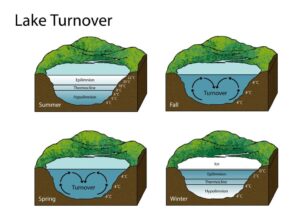Image by S. Hermann & F. Richter from Pixabay
Did you know that deep lakes, like Maxinkuckee, are “dimictic,” meaning they undergo turnover twice a year – in the spring and in the fall. This turnover is temperature driven and delivers oxygen and nutrients essential to aquatic life throughout the entirety of the lake.
Mixing Things Up

Tim Gunther
National Geographic
For most lakes deeper than 20 feet, distinct layers of water form during the summer. These layers prevent the lake from mixing and aerating. We have to go back to our school days and density of water to tell us why. Warm water is less dense than cool water, therefore, the cool water sinks to the bottom of the lake and the warm water stays on top. These layers begin to weaken when temperatures cool in the fall and the temperature throughout the water column equalizes.
Simply put, water from the bottom of the lake is able to rise to the top and water from the top of the lake sinks to the bottom. This process allows for oxygen to be replenished and nutrients distributed throughout the lake.
The same thing happens in the spring. The water temperature at the surface warms, strong spring winds help break the equilibrium and the lake begins mixing again. Oxygen from the surface mixes with the bottom, while nutrients trapped near the bottom are free to mix throughout the lake. This is why, in the spring and fall, the lake can have an unpleasant smell. Decomposing organic matter is being churned up from the bottom, a signature sign of lake turnover.

We can even track spring turnover with a Secchi disk, by measuring water clarity. During spring turnover, the clarity of the lake usually decreases because mixing brings up nutrient rich water from the bottom of the lake. This causes the lake to look cloudy. Also, the algae start growing due to readily available nutrients, which decreases water clarity. Once turnover is complete, the clarity increases. If we took Secchi disk readings and surface water temperature readings every few days in May and early June, we could track spring turnover. Any other lake nerds out there think this sounds like fun?
This amazing and natural process is one example of the dynamic ecosystem of Lake Maxinkuckee.
“I think of turnover as the lake taking a deep breath as everything is mixed. It’s like a fresh start every spring and fall.”
Robert Ladwid ~ Hydrologist
UW Center for Limnology

Hi, I’m Debbie Palmer. I received a BS in Horticulture from Purdue University. Here at LMEF, I am responsible for outreach presentations, monitoring the lake and it’s wetlands, project manager for restoration and research projects, and act as a community resource for all things related to the well-being of Lake Maxinkuckee and its surrounding watershed. I completed Indiana Watershed Leadership Academy, volunteer with the Indiana Clean Lakes Program, Hoosier River Watch and Marshall County Lakes and Waters and serve as a Board Member for Indiana Lakes Management Society.


Recent Comments